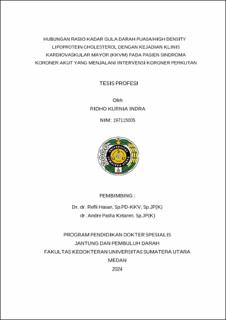Hubungan Rasio Kadar Gula Darah Puasa/ High Density Lipoprotein Cholesterol dengan Kejadian Klinis Kardiovaskular Mayor (KKYM) pada Pasien Sindroma Koroner Akut yang Menjalani Intervensi Koroner Perkutan
Correlation of Fasting Blood Glucose/High Density Lipoprotein Cholesterol Ratio with Major Cardiovascular Clinical Events (MACE) in Acute Coronary Syndrome Disease Undergoing Percutaneous Coronary Intervention

Date
2024Author
Indra, Ridho Kurnia
Advisor(s)
Hasan, Refli
Ketaren, Andre Pasha
Metadata
Show full item recordAbstract
Background: Metabolic syndrome (MetS) is the main cause of coronary artery disease with high mortality rate and fasting blood glucose (FBG)/ high density lipoprotein
(HDL)-C ratio is potential predictor which associated with an increased risk of Major
Cardiovascular Clinical Events (MACE).
Methods: This research is a retrospective observational study conducted on patients with acute coronary syndrome who underwent percutaneous coronary intervention
(PCI) and were treated at H Adam Malik General Hospital Medan from January 2022
until the sample size was met. Patients who met inclusion and exclusion criteria will be assessed Laboratory parameters include fasting blood glucose levels and HDL-C levels,
and FBG/HDL-C ratio is calculated. Numerical variables are presented as mean and
standard deviation for normally distributed data and median (minimum - maximum) for
not normally distributed data, which is then compared with Student's t-test or Mann
Whitney U, p value < 0.05 is said to be statistically significant.
Results: Mean (HDL)-C level of research sample was 38 + 8.7 mg/dl and mean fasting
blood glucose (FBG) level was 113.0 + 41.8 mg/dl. After calculations, mean GDP/HDL ratio of research sample was 3.19. The results of bivariate analysis found p value = <0.05
(Fisher Exact test with a p value = 0.016; OR 95% CI 1.378 – 11.181; Mann Whitney test with a p value = 0.001) which indicates a significant correlation between FBG/HDL
ratio with MACE in acute coronary syndrome patients undergoing percutaneous
coronary intervention with FBG/HDL ratio cut off of 3.345 showed sensitivity of 74.5% and specificity of 76.8%.
Conclusion: The FBG/HDL ratio can be used as a predictor of MACE in acute coronary syndrome patients undergoing percutaneous coronary intervention with sensitivity of 74.5% and specificity of 76.8%.
Collections
- Master Theses [107]
